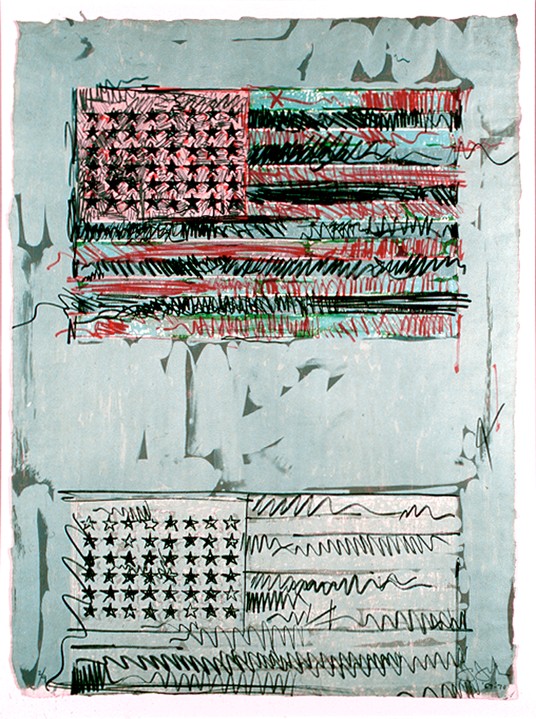Wednesday, July 4, 2012
Focus: Jasper Johns
Focus: Jasper Johns celebrated MoMA’s acquisition of a series of 13 untitled compositions from 2001 by Jasper Johns (American, b. 1930) with an exhibition of 85 prints, drawings, and paintings, all from the Museum’s significant collection of his works. On view for the first time at MoMA, Johns’s Untitled series of prints—referencing his “Catenary” theme, named for the curve formed by a cord hanging between two fixed points—show the artist cutting, pasting, painting, and drawing to make works that are linked thematically but differ widely in their expressive content. This series, along with the other works selected for this exhibition, comprise a revealing display of the artist’s creative process and demonstrate Johns’ longstanding practice of re-investigating a repertoire of images, including flags, numerals, targets, and studies of the four seasons.
On view December 5, 2008, through February 16, 2009, the exhibition was organized by Deborah Wye, The Abby Aldrich Rockefeller Chief Curator for Prints and Illustrated Books, The Museum of Modern Art.
“Just the process of printmaking allows you to do things that make your mind work in a different way,” Johns has said.
Numerals have been the most prevalent motif in Johns’s work.
Among the works on view were two variations of a portfolio entitled 0-9 (1963): one is printed in gray ink on tan paper, the other in a range of colors on white paper. All the prints were made from one lithographic stone, with Johns effacing and reworking the surface of the stone after drawing each numeral.
Decoy (1971) contains imagery from several of his earlier works. For this print, Johns had access for the first time to an offset printing press, which facilitates the use of multiple plates, photographic transfers, and layering.
After finishing Decoy , he used the leftover, rejected prints to create Decoy II (1971–73).
With Flags (1968), Johns revisited his composition and created something almost entirely new from it.
On view were a series of trial proofs that demonstrate how the artist later developed a new version entitled, Flags II (1970).
The print Savarin (1977) is based on Johns’ life-size bronze sculpture of a paint brush filled Savarin coffee can. The composition was designed first as a poster for a retrospective exhibition of his work. Johns went on to experiment extensively with this imagery.
This exhibition also included a series of six lithographs that are variations on the theme.
In the late 1980s, Johns’s works known as The Seasons were his most autobiographical to date. Their imagery combines fragmented references to the artist’s work and to his life. Incorporating personal elements such as a tracing of his own shadow was, at the time, a departure for him. A painting, drawing, and several prints on this theme are on view.
Johns has sometimes looked to other artists for themes and patterns to serve as compositional elements in his own work. While many references are known—from the work of the modern master Pablo Picasso to that of the Renaissance painter Matthias Grünewald,
Green Angel (1991) presents a shape traced from a source the artist has not identified. This motif has appeared in over 40 paintings, drawings, and prints.











